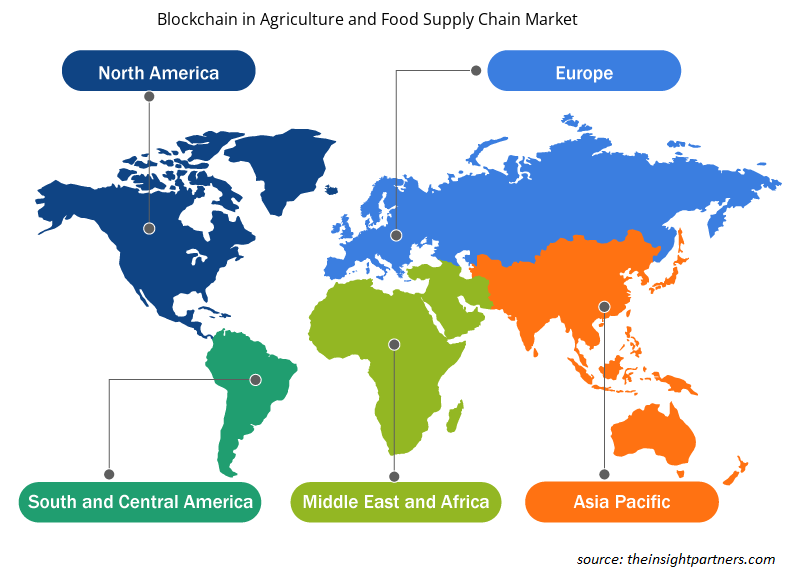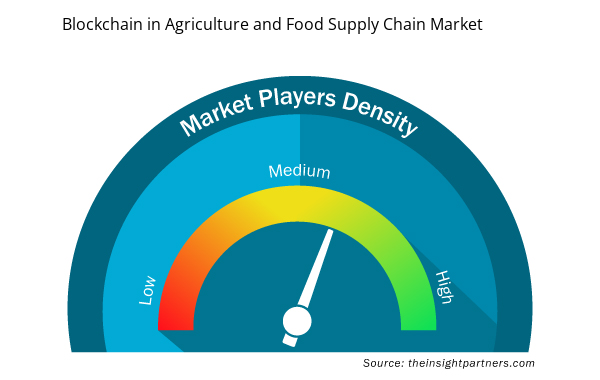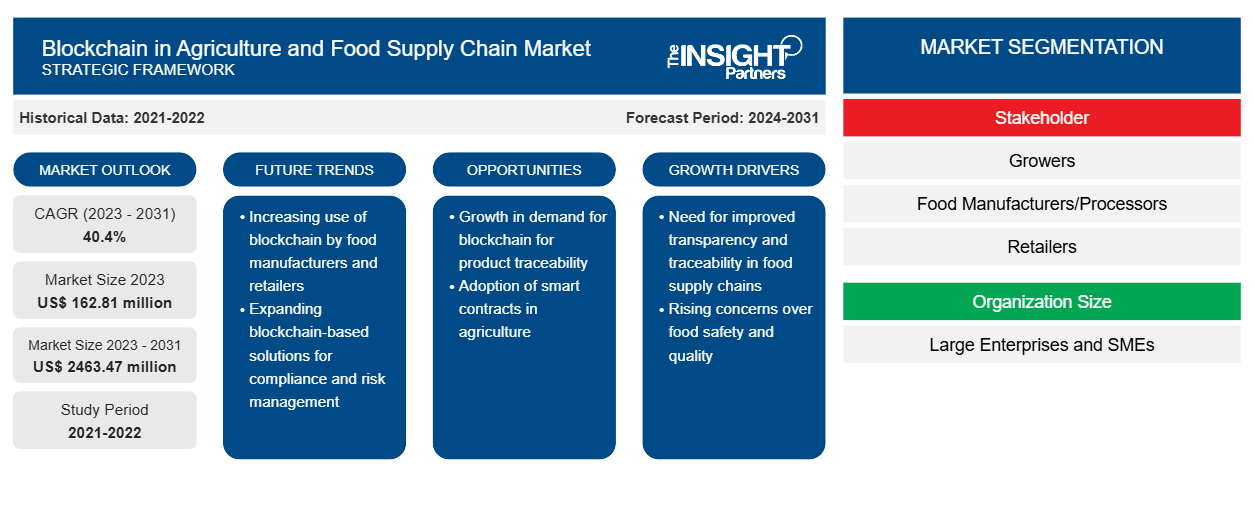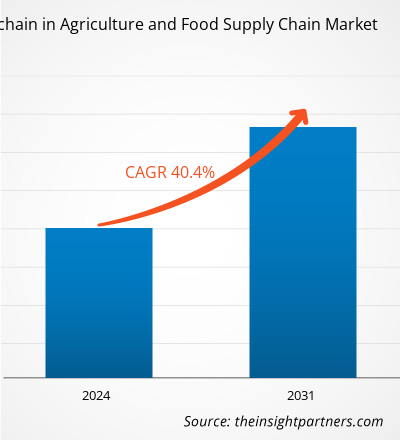Si prevede che la blockchain nel mercato della filiera agricola e alimentare crescerà da 162,81 milioni di dollari nel 2023 a 2463,47 milioni di dollari entro il 2031; si prevede che si espanderà a un CAGR del 40,4% dal 2023 al 2031. La maggiore tracciabilità e trasparenza, la domanda di trasparenza da parte dei consumatori, l'efficienza della filiera, la prevenzione delle frodi e delle contaminazioni alimentari e la riduzione degli sprechi alimentari stanno alimentando la crescita della blockchain nel mercato della filiera agricola e alimentare.
Analisi del mercato della blockchain nella filiera agricola e alimentare
La crescente domanda di tecnologia blockchain da parte di piccole e medie imprese ha rafforzato la presenza della blockchain nel mercato della filiera agricola e alimentare. Inoltre, si prevede che l'integrazione dei dispositivi Internet of Things (IoT) accelererà l'espansione dei mercati nel periodo previsto. Inoltre, le principali aziende stanno adottando varie iniziative per espandere il loro portafoglio e la loro presenza globale, che è diventata una delle principali tendenze della blockchain nel mercato della filiera agricola e alimentare.
Panoramica del mercato della blockchain nella filiera agricola e alimentare
- Le aziende legate all'agricoltura stanno diventando sempre più interessate alla tecnologia blockchain. Le aziende si distinguono gradualmente mostrando come viene creata la conoscenza della supply chain e come i colli di bottiglia delle transazioni vengono ridotti attraverso una maggiore competenza nella gestione dei dati derivante dallo sviluppo della tecnologia.
- Il settore agricolo sottolinea quanto la tecnologia sia preziosa per ridurre i costi di transazione, semplificare la logistica, aumentare la tracciabilità e migliorare le procedure di sicurezza alimentare.
- La tecnologia blockchain rappresenta un'entusiasmante opportunità per migliorare la trasparenza, ridurre le resistenze e incrementare l'efficienza delle transazioni nelle filiere agricole globali.
Personalizza questo report in base alle tue esigenze
Riceverai la personalizzazione gratuita di qualsiasi report, comprese parti di questo report, o analisi a livello nazionale, pacchetto dati Excel, oltre a usufruire di grandi offerte e sconti per start-up e università
- Scopri le principali tendenze di mercato in questo rapporto.Questo campione GRATUITO includerà analisi di dati che spaziano dalle tendenze di mercato alle stime e alle previsioni.
Blockchain in agricoltura e opportunità di mercato nella filiera alimentare
Integrazione dei dispositivi Internet of Things (IoT) per creare un'opportunità per la blockchain nella crescita del mercato della filiera agricola e alimentare
- L'integrazione dei dispositivi Internet of Things (IoT) con la tecnologia blockchain nelle filiere di approvvigionamento agricolo e alimentare migliora la raccolta dei dati e il monitoraggio in tempo reale, determinando una maggiore trasparenza, tracciabilità e controllo di qualità, nonché una maggiore efficienza della filiera.IoT) devices with blockchain technology for agriculture and food supply chains improves data gathering and real-time monitoring, leading to increased transparency, traceability, and quality control, as well as increased supply chain efficiency.
- Le aziende stanno proteggendo i dati nei dispositivi Internet of Things con la blockchain. I dispositivi intelligenti possono scambiare dati e condurre altre attività finanziarie in modo scalabile, sicuro e affidabile quando la tecnologia blockchain viene utilizzata insieme ai dispositivi IoT.scalable, secure, and reliable way when blockchain technology is used in conjunction with IoT devices.
- Inoltre, la tecnologia blockchain combinata con l'IoT consente alle organizzazioni di scambiare e accedere ai dati senza la necessità di un controllo e di una gestione centralizzati, favorendo ulteriormente la crescita della blockchain nel mercato dell'agricoltura e della filiera alimentare.IoT enables organizations to exchange and access data without the need for centralized control and management, further propelling the blockchain in agriculture and food supply chain market growth.
Blockchain nel rapporto di mercato sulla filiera agricola e alimentare, analisi della segmentazione
- In base alle dimensioni dell'organizzazione, la blockchain nel mercato della filiera agricola e alimentare è segmentata in grandi imprese e PMI. Si prevede che il segmento delle grandi imprese deterrà una quota sostanziale di mercato della blockchain nella filiera agricola e alimentare nel 2023.
- Le organizzazioni più grandi lavorano costantemente per investire in tecnologie avanzate come la blockchain per migliorare la loro filiera agricola e alimentare, alimentando così la crescita del segmento nel mercato.
- Anche le PMI stanno lavorando all'adozione della tecnologia blockchain, poiché le aiuta a tracciare e gestire i propri prodotti lungo tutta la filiera, stimolando ulteriormente la crescita del mercato nel periodo previsto.
Analisi della quota di mercato della blockchain nell'agricoltura e nella filiera alimentare per area geografica
L'ambito della blockchain nel mercato della filiera agricola e alimentare è principalmente suddiviso in cinque regioni: Nord America, Europa, Asia Pacifico, Medio Oriente e Africa e Sud America. Il Nord America sta vivendo una rapida crescita e si prevede che detenga una quota di mercato significativa della blockchain nella filiera agricola e alimentare. Il Nord America ha adottato la tecnologia moderna a un ritmo molto più rapido rispetto ad altre regioni per gestire l'agricoltura e la filiera alimentare, con conseguente maggiore quota di mercato. Inoltre, gli Stati Uniti e il Canada sono i paesi economicamente più stabili della regione, rappresentando una quota considerevole del mercato.
Blockchain nel mercato della filiera agricola e alimentare: approfondimenti regionali
Le tendenze regionali e i fattori che influenzano il mercato della blockchain in agricoltura e filiera alimentare durante il periodo di previsione sono stati ampiamente spiegati dagli analisti di Insight Partners. Questa sezione discute anche i segmenti e la geografia del mercato della blockchain in agricoltura e filiera alimentare in Nord America, Europa, Asia Pacifico, Medio Oriente e Africa e America meridionale e centrale.

- Ottieni i dati specifici regionali per Blockchain nel mercato della filiera agricola e alimentare
Blockchain nell'ambito del rapporto di mercato sulla filiera agricola e alimentare
| Attributo del report | Dettagli |
|---|---|
| Dimensioni del mercato nel 2023 | 162,81 milioni di dollari USA |
| Dimensioni del mercato entro il 2031 | 2.463,47 milioni di dollari USA |
| CAGR globale (2023-2031)CAGR (2023 - 2031) | 40,4% |
| Dati storici | 2021-2022 |
| Periodo di previsione | 2024-2031 |
| Segmenti coperti | Per parte interessata
|
| Regioni e Paesi coperti | America del Nord
|
| Leader di mercato e profili aziendali chiave |
|
Blockchain nel mercato della filiera agricola e alimentare Densità degli attori: comprendere il suo impatto sulle dinamiche aziendali
Il mercato della blockchain nel mercato della filiera agricola e alimentare sta crescendo rapidamente, spinto dalla crescente domanda degli utenti finali dovuta a fattori quali l'evoluzione delle preferenze dei consumatori, i progressi tecnologici e una maggiore consapevolezza dei vantaggi del prodotto. Con l'aumento della domanda, le aziende stanno ampliando le loro offerte, innovando per soddisfare le esigenze dei consumatori e capitalizzando sulle tendenze emergenti, il che alimenta ulteriormente la crescita del mercato.
La densità degli operatori di mercato si riferisce alla distribuzione di aziende o società che operano in un particolare mercato o settore. Indica quanti concorrenti (operatori di mercato) sono presenti in un dato spazio di mercato in relazione alle sue dimensioni o al valore di mercato totale.
Le principali aziende che operano nel mercato della Blockchain nell'agricoltura e nella filiera alimentare sono:
- IBM
- Microsoft
- TE-FOOD International GmbH
- Ambrosio
- ACR-NET
- SAP SE
Disclaimer : le aziende elencate sopra non sono classificate secondo un ordine particolare.

- Ottieni la panoramica dei principali attori chiave del mercato della blockchain nella filiera agricola e alimentare
"Analisi del mercato della blockchain nell'agricoltura e nella filiera alimentare"è stato condotto in base a stakeholder, dimensioni dell'organizzazione, applicazione e geografia. In base agli stakeholder, il mercato è segmentato in coltivatori, produttori/trasformatori di alimenti e rivenditori. In base alle dimensioni dell'organizzazione, il mercato è segmentato in grandi imprese e PMI. In base all'applicazione, la blockchain nel mercato della filiera agricola e alimentare è segmentata in tracciabilità del prodotto, pagamento e regolamento, contratti intelligenti e gestione del rischio di governance e conformità. In base alla geografia, il mercato è segmentato in Nord America, Europa, Asia Pacifico, Medio Oriente e Africa e Sud America.
Blockchain in agricoltura e filiera alimentare: notizie di mercato e sviluppi recenti
Le aziende adottano strategie inorganiche e organiche come fusioni e acquisizioni nella blockchain nel mercato della filiera agricola e alimentare. Di seguito sono elencati alcuni recenti sviluppi chiave del mercato:
- A marzo 2021, BlockApps, un fornitore di piattaforme blockchain aziendali, ha annunciato l'espansione della rete TraceHarvest con Amazon Web Services (AWS). La soluzione blockchain TraceHarvest di BlockApps sfrutterà AWS per fornire ai clienti agricoli di TraceHarvest un accesso rapido e flessibile al cloud. TraceHarvest consente ai clienti di tracciare e tracciare l'intero ciclo di vita dei prodotti agricoli a partire dalla fonte dei semi utilizzando la blockchain.
[Fonte: BlockApps, sito web aziendale]
- A gennaio 2020, Farmer Connect e IBM hanno annunciato una nuova applicazione mobile per i consumatori chiamata "Thank My Farmer", che consentirà ai bevitori di caffè di tracciare il loro caffè per comprenderne la qualità e l'origine e persino supportare l'agricoltore che ha coltivato i chicchi. Farmer Connect è una piattaforma di tracciabilità basata su IBM Blockchain progettata per aiutare ad aumentare la tracciabilità, l'efficienza e l'equità nella filiera del caffè.
[Fonte: IBM, sito web aziendale]
Copertura e risultati del rapporto di mercato sulla blockchain nella filiera agricola e alimentare
Le previsioni di mercato di Blockchain in Agriculture and Food Supply Chain sono stimate in base a vari risultati di ricerche secondarie e primarie, come pubblicazioni aziendali chiave, dati di associazioni e database. Il rapporto di mercato "Blockchain in Agriculture and Food Supply Chain Market Size and Forecast (2021–2031)" fornisce un'analisi dettagliata del mercato che copre le seguenti aree:
- Dimensioni e previsioni del mercato a livello globale, regionale e nazionale per tutti i principali segmenti di mercato interessati dall'indagine.
- Dinamiche di mercato quali fattori trainanti, limitazioni e opportunità chiave.
- Principali tendenze future.
- Analisi PEST e SWOT dettagliate
- Analisi del mercato globale e regionale che copre le principali tendenze del mercato, gli attori chiave, le normative e i recenti sviluppi del mercato.
- Analisi del panorama industriale e della concorrenza che comprende la concentrazione del mercato, l'analisi della mappa di calore, gli attori chiave e gli sviluppi recenti.
- Profili aziendali dettagliati.
- Analisi storica (2 anni), anno base, previsione (7 anni) con CAGR
- Analisi PEST e SWOT
- Valore/volume delle dimensioni del mercato - Globale, regionale, nazionale
- Industria e panorama competitivo
- Set di dati Excel



Report Coverage
Revenue forecast, Company Analysis, Industry landscape, Growth factors, and Trends

Segment Covered
This text is related
to segments covered.

Regional Scope
North America, Europe, Asia Pacific, Middle East & Africa, South & Central America

Country Scope
This text is related
to country scope.
Domande frequenti
The global blockchain in agriculture and food supply chain market was estimated to be US$ 162.81 billion in 2023 and is expected to grow at a CAGR of 40.4% during the forecast period 2023 - 2031.
Rising demand for traceability and transparency from stakeholders are the major factors that propel the global blockchain in agriculture and food supply chain market.
The strategic initiatives by market players are anticipated to play a significant role in the global blockchain in agriculture and food supply chain market in the coming years.
The global blockchain in agriculture and food supply chain market is expected to reach US$ 2463.47 million by 2031.
The key players holding majority shares in the global blockchain in agriculture and food supply chain market are IBM, Microsoft, TE-FOOD International GmbH, Ambrosus, and ACR-NET.
Trends and growth analysis reports related to Banking, Financial Services, and Insurance : READ MORE..
- IBM
- Microsoft
- TE-FOOD International GmbH
- Ambrosus
- ACR-NET
- SAP SE
- OriginTrail
- Provenance
- Chainvine
- Ripe.io
The Insight Partners performs research in 4 major stages: Data Collection & Secondary Research, Primary Research, Data Analysis and Data Triangulation & Final Review.
- Data Collection and Secondary Research:
As a market research and consulting firm operating from a decade, we have published and advised several client across the globe. First step for any study will start with an assessment of currently available data and insights from existing reports. Further, historical and current market information is collected from Investor Presentations, Annual Reports, SEC Filings, etc., and other information related to company’s performance and market positioning are gathered from Paid Databases (Factiva, Hoovers, and Reuters) and various other publications available in public domain.
Several associations trade associates, technical forums, institutes, societies and organization are accessed to gain technical as well as market related insights through their publications such as research papers, blogs and press releases related to the studies are referred to get cues about the market. Further, white papers, journals, magazines, and other news articles published in last 3 years are scrutinized and analyzed to understand the current market trends.
- Primary Research:
The primarily interview analysis comprise of data obtained from industry participants interview and answers to survey questions gathered by in-house primary team.
For primary research, interviews are conducted with industry experts/CEOs/Marketing Managers/VPs/Subject Matter Experts from both demand and supply side to get a 360-degree view of the market. The primary team conducts several interviews based on the complexity of the markets to understand the various market trends and dynamics which makes research more credible and precise.
A typical research interview fulfils the following functions:
- Provides first-hand information on the market size, market trends, growth trends, competitive landscape, and outlook
- Validates and strengthens in-house secondary research findings
- Develops the analysis team’s expertise and market understanding
Primary research involves email interactions and telephone interviews for each market, category, segment, and sub-segment across geographies. The participants who typically take part in such a process include, but are not limited to:
- Industry participants: VPs, business development managers, market intelligence managers and national sales managers
- Outside experts: Valuation experts, research analysts and key opinion leaders specializing in the electronics and semiconductor industry.
Below is the breakup of our primary respondents by company, designation, and region:

Once we receive the confirmation from primary research sources or primary respondents, we finalize the base year market estimation and forecast the data as per the macroeconomic and microeconomic factors assessed during data collection.
- Data Analysis:
Once data is validated through both secondary as well as primary respondents, we finalize the market estimations by hypothesis formulation and factor analysis at regional and country level.
- Macro-Economic Factor Analysis:
We analyse macroeconomic indicators such the gross domestic product (GDP), increase in the demand for goods and services across industries, technological advancement, regional economic growth, governmental policies, the influence of COVID-19, PEST analysis, and other aspects. This analysis aids in setting benchmarks for various nations/regions and approximating market splits. Additionally, the general trend of the aforementioned components aid in determining the market's development possibilities.
- Country Level Data:
Various factors that are especially aligned to the country are taken into account to determine the market size for a certain area and country, including the presence of vendors, such as headquarters and offices, the country's GDP, demand patterns, and industry growth. To comprehend the market dynamics for the nation, a number of growth variables, inhibitors, application areas, and current market trends are researched. The aforementioned elements aid in determining the country's overall market's growth potential.
- Company Profile:
The “Table of Contents” is formulated by listing and analyzing more than 25 - 30 companies operating in the market ecosystem across geographies. However, we profile only 10 companies as a standard practice in our syndicate reports. These 10 companies comprise leading, emerging, and regional players. Nonetheless, our analysis is not restricted to the 10 listed companies, we also analyze other companies present in the market to develop a holistic view and understand the prevailing trends. The “Company Profiles” section in the report covers key facts, business description, products & services, financial information, SWOT analysis, and key developments. The financial information presented is extracted from the annual reports and official documents of the publicly listed companies. Upon collecting the information for the sections of respective companies, we verify them via various primary sources and then compile the data in respective company profiles. The company level information helps us in deriving the base number as well as in forecasting the market size.
- Developing Base Number:
Aggregation of sales statistics (2020-2022) and macro-economic factor, and other secondary and primary research insights are utilized to arrive at base number and related market shares for 2022. The data gaps are identified in this step and relevant market data is analyzed, collected from paid primary interviews or databases. On finalizing the base year market size, forecasts are developed on the basis of macro-economic, industry and market growth factors and company level analysis.
- Data Triangulation and Final Review:
The market findings and base year market size calculations are validated from supply as well as demand side. Demand side validations are based on macro-economic factor analysis and benchmarks for respective regions and countries. In case of supply side validations, revenues of major companies are estimated (in case not available) based on industry benchmark, approximate number of employees, product portfolio, and primary interviews revenues are gathered. Further revenue from target product/service segment is assessed to avoid overshooting of market statistics. In case of heavy deviations between supply and demand side values, all thes steps are repeated to achieve synchronization.
We follow an iterative model, wherein we share our research findings with Subject Matter Experts (SME’s) and Key Opinion Leaders (KOLs) until consensus view of the market is not formulated – this model negates any drastic deviation in the opinions of experts. Only validated and universally acceptable research findings are quoted in our reports.
We have important check points that we use to validate our research findings – which we call – data triangulation, where we validate the information, we generate from secondary sources with primary interviews and then we re-validate with our internal data bases and Subject matter experts. This comprehensive model enables us to deliver high quality, reliable data in shortest possible time.


 Ottieni un campione gratuito per questo repot
Ottieni un campione gratuito per questo repot